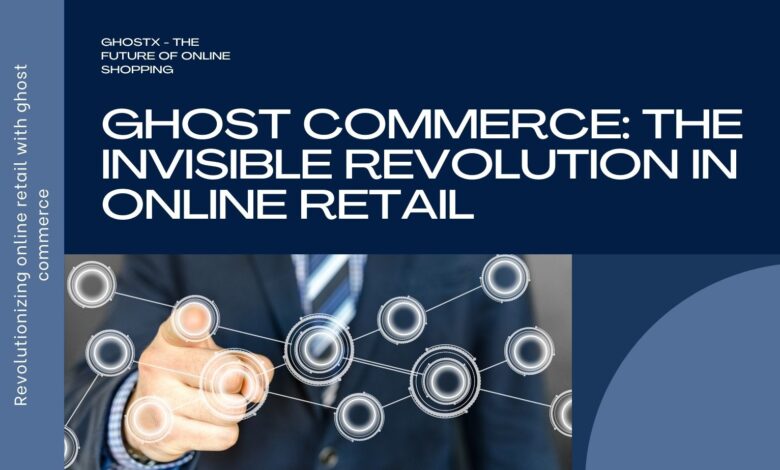Revolutionizing Online Retail: Unveiling the Power of Ghost Commerce in E-commerce”

Introduction to Ghost Commerce
In the ever-evolving landscape of e-commerce, a new player has emerged, radically transforming how online retail operates: ghost commerce. This innovative business model allows entrepreneurs to sell products without the traditional hassles of inventory and shipping management. By leveraging third-party platforms such as Printify or Printful, ghost commerce opens the door to a world where the focus shifts from logistics to branding and marketing. This article explores the intricate workings of ghost commerce, its benefits, challenges, and why it might just be the future of e-commerce.
Also Read: Ultimate Guide to ‘TosaToken io Tosa Inu Shiba Doge’: Revolutionizing the Crypto World”
Understanding the Ghost Commerce Model
At its core, ghost commerce is an e-commerce strategy that enables entrepreneurs to sell products without physically handling them. The process involves setting up an online store and partnering with third-party suppliers who fulfill orders directly to customers. This means the business owner only stocks products but focuses on customer-facing aspects like marketing and sales. The suppliers handle inventory, packaging, and shipping, making it an attractive model for those who want to avoid the complexities of traditional e-commerce logistics.
How Ghost Commerce Works
The workflow of ghost commerce, often synonymous with dropshipping, can be broken down into several steps:
- Setting Up an Online Store: Entrepreneurs create an e-commerce website on platforms like Shopify or WooCommerce, listing products provided by their third-party partners.
- Selecting Suppliers: The key to successful ghost commerce lies in choosing reliable suppliers offering quality products and efficient fulfillment services.
- Listing Products: Entrepreneurs select items from their supplier’s catalog to feature on their online store, adjusting product descriptions and prices to fit their branding.
- Processing Orders: When a customer orders, the details are forwarded to the supplier, who then prepares and ships the product directly to the customer.
- Managing Customer Relations: The store owner handles all customer interactions, including marketing, customer service, and after-sales support, while the supplier manages inventory and logistics.
The Benefits of Ghost Commerce
Ghost commerce offers several advantages, particularly for new entrepreneurs:
- Low Start-Up Costs: The initial investment is significantly reduced without a physical inventory.
- Flexibility and Scalability: Business owners can quickly test different products and markets without the risk of unsold inventory.
- Focus on Branding and Marketing: Entrepreneurs can concentrate on building a brand and driving sales, two crucial aspects of any successful e-commerce venture.
The Challenges of Ghost Commerce
Despite its benefits, ghost commerce comes with its own set of challenges:
- Dependency on Suppliers: The business model heavily relies on the reliability and efficiency of third-party suppliers.
- Competitive Market: As an increasingly popular model, ghost commerce faces stiff competition, requiring unique marketing strategies and niche targeting.
- Customer Experience Control: Since shipping and fulfillment are out of the direct control of the business owner, maintaining a consistent customer experience can be challenging.
Strategies for Successful Ghost Commerce
To navigate these challenges, entrepreneurs should:
- Carefully Select a Niche: Choosing the right products and market segment is crucial.
- Build Strong Relationships with Suppliers: Partner with reliable suppliers and communicate well.
- Invest in Marketing: Develop a robust digital marketing strategy to stand out in a crowded marketplace.
- Focus on Customer Service: Provide excellent customer support to build trust and loyalty.
Is Ghost Commerce Profitable?
Like any business model, the profitability of ghost commerce depends on various factors, including product selection, pricing strategy, and marketing effectiveness. With proper management and focus on creating a unique brand, ghost commerce can be highly profitable.
Also Read: Ultimate Guide to Binance Lido Quiz Answers Cointips: Ace the Quiz & Maximize Your Earnings
The Future of E-commerce: Ghost Commerce
Ghost commerce is well-positioned to be a significant part of the future of e-commerce. Its low barriers to entry, scalability, and focus on marketing and branding align well with the current trends in the digital marketplace. As consumer demands shift and technology evolves, ghost commerce offers a flexible and innovative approach for entrepreneurs looking to enter the e-commerce space.
Conclusion
Ghost commerce represents a paradigm shift in the world of online retail. Eliminating the need for inventory management and shipping logistics allows entrepreneurs to focus on what truly matters – building a brand and connecting with customers. As the e-commerce landscape continues to evolve, ghost commerce stands out as a model combining flexibility, scalability, and a customer-centric approach, making it an increasingly popular choice for new and seasoned entrepreneurs.



